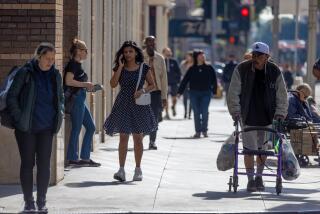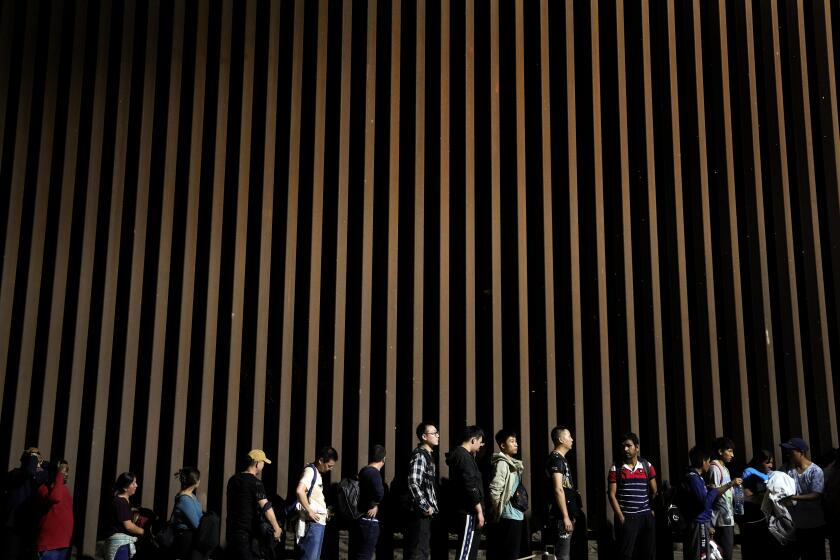A Door Opens : Immigrant’s Successful Challenge of University’s Residency Rules on Tuition Leads Way for Others
Manuel Sahagun, an undocumented immigrant who had lived in California since 1973, faced a difficult choice when he decided to pursue a college education.
If he acknowledged his lack of U.S. citizenship in his application to UC Irvine, he would be charged out-of-state tuition of more than $3,800 a year, which he could not afford.
By falsely claiming citizenship, Sahagun knew he would be charged at the affordable rate for California residents but would jeopardize his pending application for legal residency and acceptance at UCI.
“I didn’t write down that I was a citizen,” said Sahagun, who had accumulated a 3.8 grade-point average while attending Dominguez High School in Compton. “I just said the truth, that I’ve been living here illegally since December of 1973. I knew that (otherwise) I would jeopardize my future. I just told the truth, and at the time I was classified as an out-of-state resident.”
Policy Challenged
The university policy requiring that undocumented residents be charged out-of-state tuition meant Sahagun--and students like him across California--would not have been able to make ends meet. Even with a $20,000 scholarship from John J. Gogian, a Compton businessman, Sahagun would have only had $1,200 per year for other expenses after paying approximately $3,800 for tuition.
Enter the Mexican American Legal Defense and Education Fund, which went to court to challenge the policy of the University of California and the California State University systems. Sahagun acted as one of five anonymous plaintiffs in the suit. Last summer, a Superior Court judge decided against the university systems and ruled that undocumented immigrants should be considered natives for the purpose of tuition. The university systems declined to appeal.
“We chose Manuel because he was the typical example of the kind of student who was being locked out of an educational opportunity,” said Linda Wong, director of the immigrants-civil rights program for the fund.
Sahagun was 7 years old when his father, a peasant in Jamay, Jalisco, a small Mexican town more than 1,000 miles from the border, immigrated with his wife and six children to the United States. His family now includes two U.S.-born brothers.
Sees Opportunity for Others
Now 19, Sahagun said the case already has influenced his family; a brother also will attend UCI this year. And, he said, he hopes the case will mean that more high school students will now take advantage of the opportunity.
“As soon as high school students know that they can apply even though they’re undocumented, I think you’re going to see a whole bunch of students,” he said.
“We’re going to wait about three or four years to really see the impact of the case because right now we have a lot of 11th-graders who are not taking classes that are required to apply to the (university),” said Sahagun, who is considering a career in law or politics. “I think we should start letting the ninth-graders know even if they’re undocumented they should still take classes that are required.”
Some educators hailed the ruling but predicted its impact may not be felt for several years.
Sympathy of Official
James Dunning, UCI director of admissions, said the UC and CSU policies had unfairly restrained students from receiving a post-secondary education.
“I’m particularly sensitive to a student, who is undocumented through no fault of their own--I hate to see that kind of student penalized,” Dunning said.
UCI and Cal State Fullerton officials also applauded the ruling, saying it could open the door to those already underrepresented in the colleges and universities. According to the California Post Secondary Education Commission’s fall 1984 statistics, Latinos accounted for 7% and blacks made up 4.1% of the student population in the UC system; in the CSU system, Latinos totaled 9.4% and black students accounted for 6% of the students. The Santa Ana Unified School District, which has a 69% Latino student population, and which some school officials believe also includes a large number of undocumented immigrants, is likely to benefit, school officials say.
Motivation Program
The Santa Ana School system, Cal State Fullerton, UCI and Rancho Santiago Community College, currently are cooperating in a program called STEP which is aimed at motivating minority students to go to college.
Manuel Gomez, director of the Educational Opportunity Program and Student Affirmative Action outreach at UCI, said the court case is “a morale booster for young people to no longer have a ceiling placed by the state of California on their educational advancement. These students basically had no opportunity outside of the 12th grade.”
The California State University system is still in the process of developing procedures for handling applications by undocumented residents. At Cal State Fullerton, students who want to apply as state residents must attach a form stipulating that they are not legal residents. The admissions office then makes inquiries about the student and determines his resident status, said Mildred Scott, acting dean of admissions at the campus.
Attended UCI Last Year
In the University of California system, undocumented applicants need only to show that they have lived in the state for more than one year and plan to establish permanent residency.
UCI officials, recognizing that the lawsuit was pending, allowed Sahagun to attend last year as a California resident.
Sahagun, who obtained his resident status earlier in the year, said his parents had wanted him to work after he graduated from high school. Because they never completed elementary school in Mexico, he said, they never really knew the value of education, especially in this country. Now his parents, he said, are encouraging the rest of the family to continue their education.
More to Read
Start your day right
Sign up for Essential California for news, features and recommendations from the L.A. Times and beyond in your inbox six days a week.
You may occasionally receive promotional content from the Los Angeles Times.






